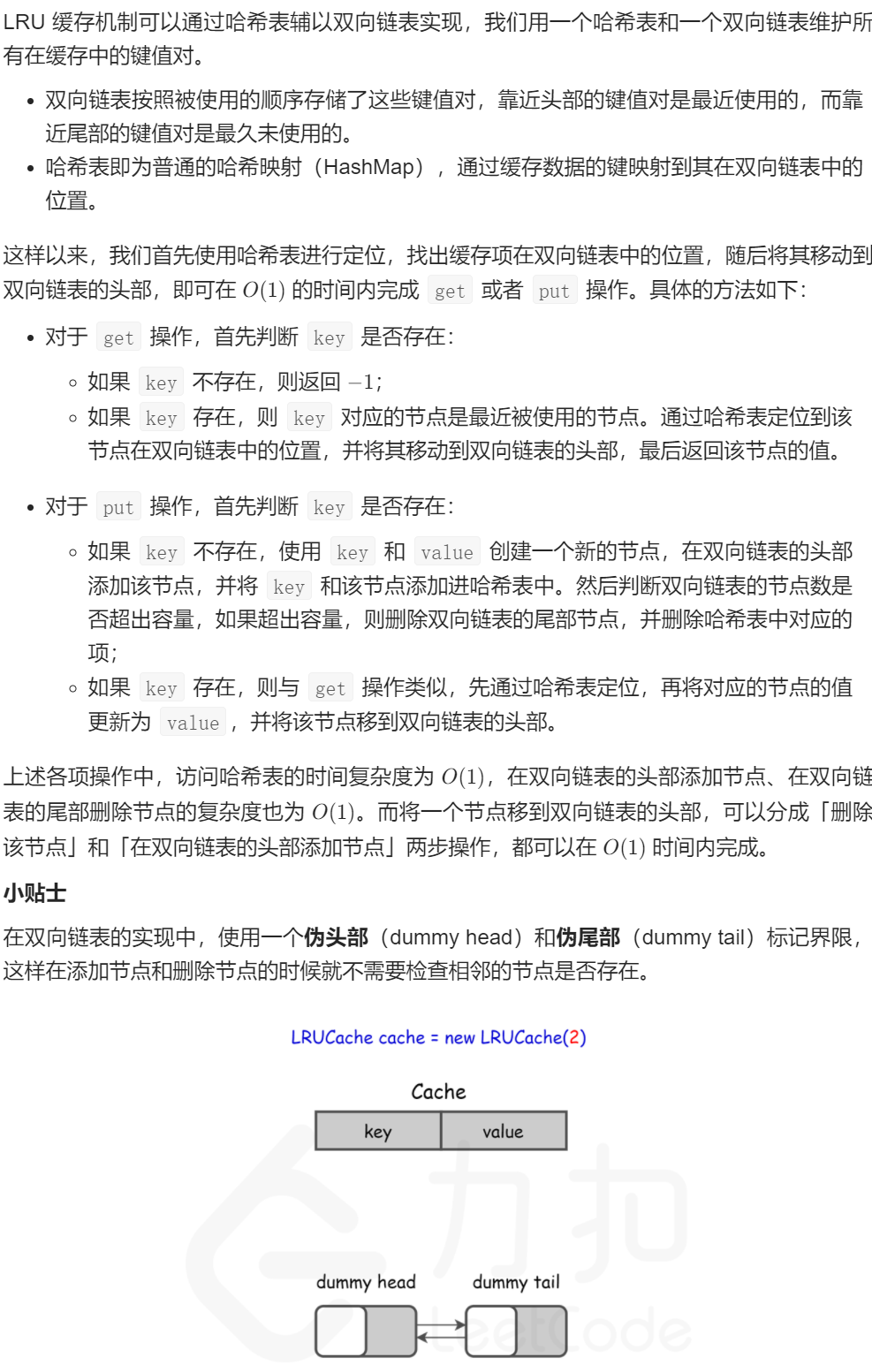146. LRU 缓存机制 + 哈希表 + 自定义双向链表
题目来源
题目描述
实现 LRUCache 类:
LRUCache(int capacity)以 正整数 作为容量capacity初始化 LRU 缓存int get(int key)如果关键字key存在于缓存中,则返回关键字的值,否则返回-1。void put(int key, int value)如果关键字key已经存在,则变更其数据值value;如果不存在,则向缓存中插入该组key-value。如果插入操作导致关键字数量超过capacity,则应该 逐出 最久未使用的关键字。
函数 get 和 put 必须以 O(1) 的平均时间复杂度运行。
示例:
输入
["LRUCache", "put", "put", "get", "put", "get", "put", "get", "get", "get"]
[[2], [1, 1], [2, 2], [1], [3, 3], [2], [4, 4], [1], [3], [4]]
输出
[null, null, null, 1, null, -1, null, -1, 3, 4]
解释
LRUCache lRUCache = new LRUCache(2);
lRUCache.put(1, 1); // 缓存是 {1=1}
lRUCache.put(2, 2); // 缓存是 {1=1, 2=2}
lRUCache.get(1); // 返回 1
lRUCache.put(3, 3); // 该操作会使得关键字 2 作废,缓存是 {1=1, 3=3}
lRUCache.get(2); // 返回 -1 (未找到)
lRUCache.put(4, 4); // 该操作会使得关键字 1 作废,缓存是 {4=4, 3=3}
lRUCache.get(1); // 返回 -1 (未找到)
lRUCache.get(3); // 返回 3
lRUCache.get(4); // 返回 4
提示:
1 <= capacity <= 30000 <= key <= 100000 <= value <= 105- 最多调用
2 * 105次get和put
题解分析

解法一:使用java自带的LinkedHashMap
- 考虑到LinkedHashMap中的元素是按序插入的,利用这个性质,可以维护队列保持“最久最少使用”的特性。
- 需要注意的是,LinkedHashMap中插入元素是在队列尾插入的,在容量大于capacity时,需要将队列头的元素删除,即表示删除最旧的元素。
class LRUCache {
int capacity;
LinkedHashMap<Integer, Integer> map;
public LRUCache(int capacity) {
this.capacity = capacity;
map = new LinkedHashMap<>();
}
public int get(int key) {
if(!map.containsKey(key)){
return -1;
}
int val = map.get(key);
// 设置为最新使用
setToNewest(key);
return val;
}
public void put(int key, int value) {
if(map.containsKey(key)){
map.put(key, value);
setToNewest(key);
return;
}
if(map.size() == capacity){
// 获取最旧的元素,在队列头
int headKey = map.keySet().iterator().next();
map.remove(headKey);
}
map.put(key, value);
}
private void setToNewest(int key){
int val = map.get(key);
map.remove(key);
map.put(key, val);
}
}
/**
* Your LRUCache object will be instantiated and called as such:
* LRUCache obj = new LRUCache(capacity);
* int param_1 = obj.get(key);
* obj.put(key,value);
*/
解法二:自定义双向链表
class LRUCache {
class DLinkedListNode{
int key, value;
DLinkedListNode pre, next;
DLinkedListNode(){}
DLinkedListNode(int key, int value){
this.key = key;
this.value = value;
}
}
// 将指定节点添加到头结点
private void addToHead(DLinkedListNode node){
node.pre = head;
node.next = head.next;
head.next.pre = node;
head.next = node;
}
// 移除节点
private void removeNode(DLinkedListNode node){
node.pre.next = node.next;
node.next.pre = node.pre;
}
// 将指定节点移动到头结点
private void removeToHead(DLinkedListNode node){
removeNode(node);
addToHead(node);
}
// 移除尾结点
private DLinkedListNode removeTail(){
DLinkedListNode node = tail.pre;
removeNode(node);
return node;
}
int capacity;
Map<Integer, DLinkedListNode> cache;
DLinkedListNode head, tail;// 虚拟头尾节点
public LRUCache(int capacity) {
this.capacity = capacity;
this.cache = new HashMap<>();
head = new DLinkedListNode();
tail = new DLinkedListNode();
head.next = tail;
tail.pre = head;
}
public int get(int key) {
if(!cache.containsKey(key)){
return -1;
}
DLinkedListNode node = cache.get(key);
removeToHead(node);
return node.value;
}
public void put(int key, int value) {
if(cache.containsKey(key)){
DLinkedListNode node = cache.get(key);
node.value = value;
removeToHead(node);
return;
}
if(cache.size() == capacity){
DLinkedListNode node = removeTail();
cache.remove(node.key);
}
DLinkedListNode node = new DLinkedListNode(key, value);
addToHead(node);
cache.put(key, node);
}
}
/**
* Your LRUCache object will be instantiated and called as such:
* LRUCache obj = new LRUCache(capacity);
* int param_1 = obj.get(key);
* obj.put(key,value);
*/
复杂度分析

Either Excellent or Rusty



【推荐】国内首个AI IDE,深度理解中文开发场景,立即下载体验Trae
【推荐】编程新体验,更懂你的AI,立即体验豆包MarsCode编程助手
【推荐】抖音旗下AI助手豆包,你的智能百科全书,全免费不限次数
【推荐】轻量又高性能的 SSH 工具 IShell:AI 加持,快人一步
· 基于Microsoft.Extensions.AI核心库实现RAG应用
· Linux系列:如何用heaptrack跟踪.NET程序的非托管内存泄露
· 开发者必知的日志记录最佳实践
· SQL Server 2025 AI相关能力初探
· Linux系列:如何用 C#调用 C方法造成内存泄露
· Manus爆火,是硬核还是营销?
· 终于写完轮子一部分:tcp代理 了,记录一下
· 别再用vector<bool>了!Google高级工程师:这可能是STL最大的设计失误
· 单元测试从入门到精通
· 震惊!C++程序真的从main开始吗?99%的程序员都答错了
2020-02-21 LeetCode-对称二叉树
2020-02-21 LeetCode-二叉树的镜像
2020-02-21 LeetCode-[list-of-depth-lcci]